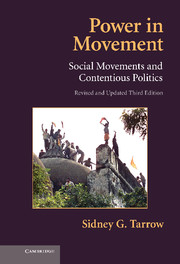Book contents
- Frontmatter
- Contents
- List of Figures
- List of Tables
- Preface
- Acknowledgments
- Introduction
- 1 Contentious Politics and Social Movements
- PART I THE BIRTH OF THE MODERN SOCIAL MOVEMENT
- PART II POWERS IN MOVEMENT
- PART III DYNAMICS OF CONTENTION
- Conclusions: The Future of Social Movements
- Sources
- Index
- Titles in the series
Conclusions: The Future of Social Movements
Published online by Cambridge University Press: 05 June 2012
- Frontmatter
- Contents
- List of Figures
- List of Tables
- Preface
- Acknowledgments
- Introduction
- 1 Contentious Politics and Social Movements
- PART I THE BIRTH OF THE MODERN SOCIAL MOVEMENT
- PART II POWERS IN MOVEMENT
- PART III DYNAMICS OF CONTENTION
- Conclusions: The Future of Social Movements
- Sources
- Index
- Titles in the series
Summary
The month of May 2010 was an active one for contentious politics in Europe:
In Athens, on the 5th, three people were killed as protesters set fire to a bank during a general strike over planned austerity measures.
On the same day, Chancellor Angela Merkel was heckled in the German Parliament as she urged MPs to back the country's €22.4bn bailout for Greece.
In Madrid the main union federation called a strike of public sector workers over the Socialist government's tough new austerity program.
These events – and many more – were the direct or indirect results of the global financial crisis that began in the American housing market in 2008 and ultimately diffused around the world. Not that there were no domestic effects: The so-called “Tea Party movement” that we discussed in Chapter 5 was a direct effect of the collapse of the American housing market and the bailout of Wall Street banks. But other effects occurred around the planet:
In January 28, in financially beleaguered Iceland, following the collapse of the country's currency, large outbursts of public protest forced the cabinet to resign.
On February 20, Latvia's center-right government also collapsed, a victim of the country's economic and political turmoil.
In Hungary, the economic crisis offered an opportunity for the comeback of Victor Orban, the leader of Hungary's conservative opposition.
Ukraine and Georgia moved into a period of political uncertainty.
- Type
- Chapter
- Information
- Power in MovementSocial Movements and Contentious Politics, pp. 259 - 274Publisher: Cambridge University PressPrint publication year: 2011



